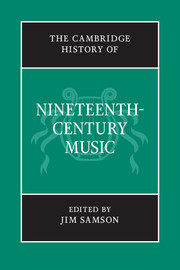Book contents
- Frontmatter
- Part One 1800–1850
- 1 The musical work and nineteenth-century history
- 2 Music And the rise of aesthetics
- 3 The profession of music
- 4 The opera industry
- 5 The construction of Beethoven
- 6 Music and the poetic
- 7 The invention of tradition
- 8 Choral music
- 9 The consumption of music
- 10 The great composer
- Part Two 1850–1900
- Chronology
- Institutions
- Personalia
- Index
- References
1 - The musical work and nineteenth-century history
from Part One - 1800–1850
Published online by Cambridge University Press: 28 March 2008
- Frontmatter
- Part One 1800–1850
- 1 The musical work and nineteenth-century history
- 2 Music And the rise of aesthetics
- 3 The profession of music
- 4 The opera industry
- 5 The construction of Beethoven
- 6 Music and the poetic
- 7 The invention of tradition
- 8 Choral music
- 9 The consumption of music
- 10 The great composer
- Part Two 1850–1900
- Chronology
- Institutions
- Personalia
- Index
- References
Summary
Compositional and contextual histories
Even the formula ‘compositional and contextual’, suggestive of a dual perspective – a ‘double root’ – may not fully embrace the materials and methods of a music history, whose very subject-matter must be open to debate. Texts, sounds, activities: all are primary data – objects, facts and events that are variously fore-grounded, ordered and interpreted to generate our narratives. One obvious starting-point would be to place musical works centre stage, prioritising the cultural forms in which art music has most often been presented in the West. But that signals an analytical enquiry. If we want to write history we need to fill the spaces between works, to find strategies for connecting them. Two such strategies, conversely related, are prominent in histories of nineteenth-century music. One is intertextuality. We join up the works through similarity, as we might note the resemblances between visual stills. This quickly brings us to composers, to suggestions of influence or mutuality, and eventually to stylistic genealogies. The explanatory focus shifts – one may justly say ‘reverts’, for this is the mode of the past, of the nineteenth century itself – from the work to its creator. The present volume is well served by this approach, and there are strong arguments for privileging it, given the historicism of the age. Yet, paradoxically, intertextuality risks undermining ‘work character’. If I choose to focus on the work, after all, I presumably value that quality of uniqueness that marks it off as more than the instantiation of a type. I celebrate its individuality, its embodiment of a singular idea.
- Type
- Chapter
- Information
- The Cambridge History of Nineteenth-Century Music , pp. 1 - 28Publisher: Cambridge University PressPrint publication year: 2001



